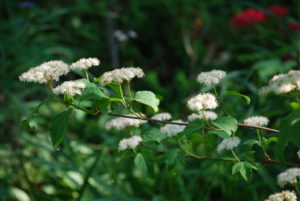Maple-leaf Viburnum (Viburnum acerifolium) is a small to medium deciduous shrub that is indigenous to many areas of the Eastern U.S. (USDA hardiness zones 3-8). This underutilized native viburnum is at its finest in a dappled shady woodland landscape. Slow-growing at first, a single plant may reach heights of 4-6 feet and 2-4 feet in spread. Maple-leaf viburnum displays multi-season interest for its spring bloom, late summer fruiting, and fall color.
Terminal clusters of white flowers (flattened cymes) form about a month emergence of the leaves in May to June. Oval green fruits soon follow that begin turning bluish-black in late summer. Flower clusters measure 2 – 3 inches across. Birds and other wildlife munch on the fruits during the winter.
Coarsely toothed, mostly three-lobed, medium green leaves turn reddish-purple to magenta color in fall. Leaves usually have small black spotting on the undersides.
Mapleleaf viburnum is more shade tolerant than most Viburnum species. It grows in average, medium moist, well-drained soil and in full sun to part shade; it tolerates a wide range of soils. Established 2 year old plants demonstrate good drought tolerance. Feed once in early spring with a granular fertilizer such as 10-10-10 or equivalent @ 1 -2 lbs. per 100 square feet. Keep shrub(s) mulched to retain soil moisture and reduce weed pressure. Irrigate during establishment and extended dry periods.
Within 4-5 weeks after flowering, prune to shape and maintain the shrub as desired. Plants will naturalize via root suckering to form colonies unless suckering is held in check. Suckering is a lot less in dry shade. In an open woodland area, it may take 5 or more years before it starts to naturalize.
No serious insect or disease problems trouble this woodsy viburnum. It may be utilized in shrub borders, foundations or hedges. Maple-leaf viburnum is primarily available from e-commerce native plant nurseries.


 Posted in
Posted in 
